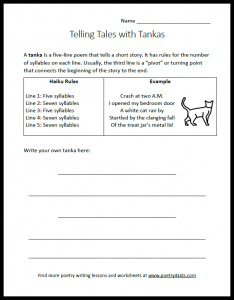Tanka, which means “short song,” has been an important literary form in Japanese culture for nearly a thousand years. The original Japanese form of tanka had only one line of poetry containing 31 speech sounds—what we would call syllables. However, most tanka poems that are written in English today are broken into five poetic lines with a certain number of syllables in each line.
The basic structure of a tanka poem is 5 – 7 – 5 – 7 – 7. In other words, there are 5 syllables in line 1, 7 syllables in line 2, 5 syllables in line 3, and 7 syllables in lines 4 and 5. If you have ever written a haiku, you will notice that tanka is kind of like a longer version of haiku that gives you a little more room to tell a story. Here is one example of a tanka poem:
Crash at two A.M.
I opened my bedroom door
A white cat ran by
Startled by the clanging fall
Of the treat jar’s metal lid
Looking at this example, you might have noticed that there is no end punctuation or rhyming used in tanka.
If you read this example carefully, you might also see that there is something special about the third line, “A white cat ran by.” This line is called the “pivot,” which means a turning point. The pivot divides the tanka into two different sections, which are joined in the middle in order to tell the whole story. The first section uses the pivot as the ending line:
Crash at two A.M.
I opened my bedroom door
A white cat ran by
Notice that this is a complete image that tells us part of a story. If we only read these three lines, we would still understand that the loud noise was somehow caused by a cat. Now look at the last three lines of the tanka, with the pivot as the first line of a new section:
A white cat ran by
Startled by the clanging fall
Of the treat jar’s metal lid
This is also a complete image, which gives us an idea of why the white cat is running away.
Now look at the tanka and see how the line “A white cat ran by” is used to connect the two sections to create the full story, which begins with a loud noise in the middle of the night and ends just a moment later with the explanation for the noise:
Crash at two A.M.
I opened my bedroom door
A white cat ran by
Startled by the clanging fall
Of the treat jar’s metal lid
You might also notice that this tanka contains detailed language that helps us imagine what it felt like to be there in the story. For example, instead of saying “I woke up in the middle of the night,” the poem starts with the words “Crash at two A.M.” The poem also uses the word “clanging” to describe the noise, and “a white cat” gives us a more distinct visual image than just the words “a cat.” Using words that paint a picture in the readers imagination is called “imagery.”
Now that you know about the parts of a tanka poem, you can try your hand at writing your own tanka. First, think of a funny or interesting situation that happened to you (or someone you know). Write down a few sentences that describe the situation: who was there, what action was taken, and what resulted from that action. Make a list of powerful words that will help the reader imagine the story, with details about what you saw, heard, and felt in the situation. What you have written so far will be your notes that will help you write the poem. Now, use this pattern to start forming your tanka:
5 syllables in line 1
7 syllables in line 2
5 syllables in line 3
7 syllables in line 4
7 syllables in line 5
You may want to speak the lines aloud, or even count on your fingers, in order to get just the right number of syllables in each line.
Most people see it as a fun challenge to fit an interesting story into this pattern of syllables. But what if you find it frustrating? You don’t have to give up on tanka just because counting syllables isn’t your thing. In fact, some poets who write tanka in English don’t even use the 5 – 7 – 5 – 7 – 7 format. Instead, they simply alternate the lengths of the lines: short / long / short / long / long. If you decide to write your tanka this way, be sure to use strong visual words and concrete details to bring your story to life, and try to include a pivot line. Most importantly, have fun!
- Update to Poems-by-Length Page - April 18, 2024
- Create Your Own Poetic Puppet Show - April 16, 2024
- Leap into Laughter with “A Festival for Frogs” - March 26, 2024







